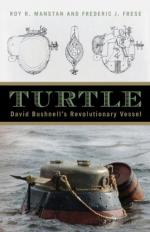|
This section contains 403 words (approx. 2 pages at 300 words per page) |
World of Invention on David Bushnell
David Bushnell grew up on a family farm in a rural area near Saybrook, Connecticut. After his father's death, Bushnell sold the farm and decided to pursue an education at Yale, starting in 1771. While at Yale he discovered that, contrary to popular belief, gunpowder would explode underwater and that the density of water actually increases the effectiveness of an explosion. After graduating in 1775 Bushnell returned to Saybrook, where he began building a one-man submarine designed to deliver an explosive charge to the hull of a warship.
Bushnell's submarine became known as the Turtle because the contour of its hull vaguely resembled a turtle floating head up and tail down in the water. Thought to have been constructed mainly of wood, the Turtle had room for one operator and held enough air to remain submerged for up to thirty minutes. Horizontal and vertical propulsion was provided by two hand-operated screw propellers projecting from the top and front of the vessel. Steering was controlled by a rudder at the rear, and a system of foot-operated pumps regulated the amount of water in the ballast tank for ascents and descents. The Turtle'snavigation instruments included a depth gauge and a compass lit by phosphorus. After maneuvering into position, the operator would attach a gunpowder charge below the waterline of a ship by driving a large screw into the hull with a crank inside the sub. As the submarine moved away from the ship, a time-delay detonator would be activated, allowing the operator to leave the area safely before the gunpowder charge exploded.
In 1776 Ezra Lee, a colonial soldier, made the first attempt to use the Turtle in actual warfare. Lee successfully maneuvered the submarine through New York Harbor to a position below the H.M.S Eagle, a British warship. He was unable, however, to drive the mine attachment screw into the copper-clad hull of the Eagle and ultimately released the charge, which floated away and exploded harmlessly. Attempts to sink other ships were similarly unsuccessful.
Bushnell later joined the Continental army as an engineer and briefly served as the commander of the Corps of Engineers at West Point. After retiring from military service, Bushnell travelled to France and then returned to America to teach at a school in Georgia. Although his submarine ultimately failed to carry out its intended purpose, the Turtle is nevertheless recognized as the first submarine to be used in warfare.
|
This section contains 403 words (approx. 2 pages at 300 words per page) |


